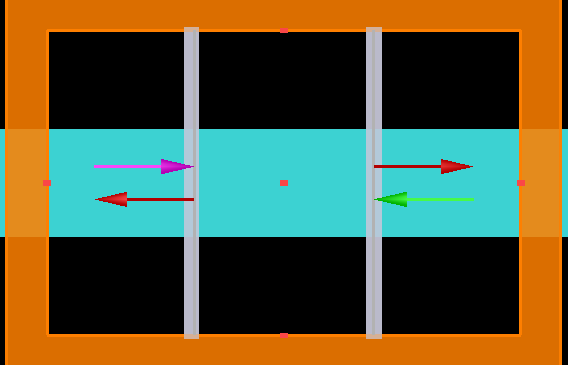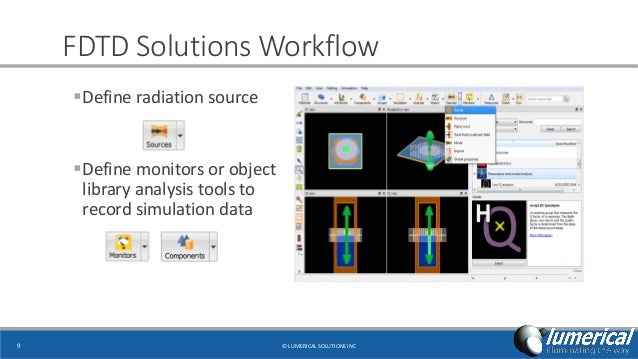

- #Lumerical fdtd manual how to
- #Lumerical fdtd manual manuals
- #Lumerical fdtd manual install
- #Lumerical fdtd manual software
- #Lumerical fdtd manual license
You will need to have the Lumerical software installed on your desktop or laptop. Caveat: When running outside of CNM (which is possible), you will need an active network connection to NST. #Lumerical fdtd manual license
The application needs to be installed on your machine and be configured to obtain the Lumerical license over the network from Carbon. Run the "FDTD Solutions" application directly, or "natively" on your machine. Here are considerations to help you choose:
Run on Carbon in a VNC virtual desktop and display that desktop on your machine. Run on Carbon and display on your machine over X11 forwarding. Run on your desktop or laptop directly and use license port forwarding. In every situation, the application requires network access to a Lumerical license service running on Carbon.įor the GUI applications, there are three ways to run: The Lumerical applications, both GUI and compute engines, can be run on any desktop or laptop computer, and on our HPC cluster, Carbon. To request access, submit a support request. Notably limiting user eligibility and reducing concurrent capabilities of solvers.Īccess to Lumerical is limited to Argonne staff who are CNM users, and to CNM staff. Lumerical was originally produced by Lumerical, Inc., which has been acquired by Ansys in 2020.Īnsys introduced major changes to the Lumerical licensing engine and terms, A solver, or engine, licensed by compute job. The applications typically have two primary components. 
Others are Multiphysics (formerly DEVICE), MODE, and INTERCONNECT. Lumerical consists of several applications, the most popular being FDTD Solutions to perform photonics modeling.
6 Running compute jobs within fdtd-engine (FDTD).  5.3 File-based license configuration (advanced). 5.1 When inside CNM or using VPN as a CNM staff member or postdoc. 5 Configuring license access when not running on Carbon directly. 4 Ways to run Lumerical compute engine applications. 3 Ways to run Lumerical GUI applications. Once the simulation is complete, you can open S:\nanowire\nanowire.fsp from FDTD Solutions on your workstation to view the results. You can view the status of your job with the “squeue -u ” command. Finally, you can change to your job’s directory, and run the sbatch command to submit the job: Module add compilers/intel/2013_cluster_xeĤ. # SLURM 8 processor Lumerical test to run for 1 hour. The script below (for testing, name it “lumerical-test.sh”) can be copied into your job directory (the folder with your input files) and modified so that you can submit batch processes to the queue. Next, create a script for your job, and submit it to SLURM. Then, log into CIRCE via SSH and change your directory to ~/nanowire, which is the same directory that appears on your S: drive: cd nanowire]$ģ. From your workstation, save your project to S:\nanowire\nanowire.fspĢ.
5.3 File-based license configuration (advanced). 5.1 When inside CNM or using VPN as a CNM staff member or postdoc. 5 Configuring license access when not running on Carbon directly. 4 Ways to run Lumerical compute engine applications. 3 Ways to run Lumerical GUI applications. Once the simulation is complete, you can open S:\nanowire\nanowire.fsp from FDTD Solutions on your workstation to view the results. You can view the status of your job with the “squeue -u ” command. Finally, you can change to your job’s directory, and run the sbatch command to submit the job: Module add compilers/intel/2013_cluster_xeĤ. # SLURM 8 processor Lumerical test to run for 1 hour. The script below (for testing, name it “lumerical-test.sh”) can be copied into your job directory (the folder with your input files) and modified so that you can submit batch processes to the queue. Next, create a script for your job, and submit it to SLURM. Then, log into CIRCE via SSH and change your directory to ~/nanowire, which is the same directory that appears on your S: drive: cd nanowire]$ģ. From your workstation, save your project to S:\nanowire\nanowire.fspĢ. #Lumerical fdtd manual how to
For help on submitting jobs to the queue, see our SLURM User’s Guide.īelow is an example of how to run FDTD Solutions on CIRCE using your S: drive and locally-installed FDTD Solutions software.ġ. Your SLURM executables, tools, and options may vary from the example below.
Note: Scripts are provided as examples only. Note on CIRCE: Make sure to run your jobs from your $WORK directory!. Please refer to the Documentation section for a link to the guide. The guide and this page should help you to get started with your simulations. The Lumerical FDTD user guide is essential to understanding the application and making the most of it. For information on performing this process, see the following guide: Accessing Your Data Running Lumerical FDTD on CIRCE This way, it is available on the cluster when you decide its time to run a distributed analysis. It is HIGHLY RECOMMENDED that you map your home directory to your S: drive and save all FDTD solution work to it. Click Ok on the previous license dialog and close FDTD Solutions (A few errors may pop up here, which can be ignored). Click on 'Submit' and close the browser window. Specify the Server Name as license2.rc.usf.edu and the port as 27000. Choose "FlexNet Licensing" as the license type. A dialog for license configuration will appear. Complete Installation and start FDTD Solutions from start menu or equivalent. #Lumerical fdtd manual install
When prompted for MPICH2 subsystem, do not install. Authorized research groups from the College of Engineering.  4.2 Benchmarks, Known Tests, Examples, Tutorials, and Other Resourcesįrom the FDTD Solutions web site: Employing the industry proven finite-difference time-domain (FDTD) method, FDTD Solutions empowers designers to confront the most challenging optical design problems.
4.2 Benchmarks, Known Tests, Examples, Tutorials, and Other Resourcesįrom the FDTD Solutions web site: Employing the industry proven finite-difference time-domain (FDTD) method, FDTD Solutions empowers designers to confront the most challenging optical design problems. #Lumerical fdtd manual manuals
4.1 Home Page, User Guides, and Manuals. 2 Install FDTD Solutions on a workstation.








 0 kommentar(er)
0 kommentar(er)
